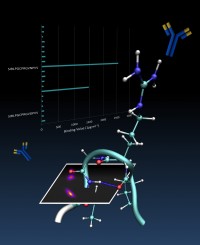Investigating new ways of detecting cancers

A joint project to investigate new ways of detecting certain cancers has published its research in The Journal of Biological Chemistry, a highly rated interdisciplinary journal in the field of biochemistry and molecular biology.
Two hormones critical in the early stages of pregnancy - hCG and LH - were investigated by a team drawn from the School's Institute for Condensed Matter & Complex Systems, the UK's National Physical Laboratory (NPL), IBM T.J. Watson Research Center in New York and UK-based company Mologic Ltd.
Commercial pregnancy tests screen for the presence of hCG, but although its role as a tumour marker in a variety of cancers is of great clinical significance, it is not well understood. Before diagnostic tests based on hCG can be developed, it is necessary to first find a way of detecting its various forms while also distinguishing it from other closely related hormones.
The research team found that a particular antibody can discriminate between fragments of hCG and similar hormones that differ only by a single amino acid - this recognition process is analogous to a lock and key, where only one combination of antibody and hormone is possible. The structures of the hormone fragments were determined through a combination of computational simulations and spectroscopic measurements.
The team hopes that this research will lead to pharmaceutical companies developing new technologies for the early detection of certain cancers.
"The scientific conclusions are, we believe, widely applicable to peptide-antibody interactions in general, and also illuminate the strategy that should be followed in exploring such bio-molecular phenomena underpinning high-value commercial diagnostic products." Mologic's Chief Scientific Officer, Paul J Davis.
For further information about this work, see the article 'Antibody recognition of a human chorionic gonadotropin epitope (hCGβ66-80) depends on local structure retained in the free peptide' in the Journal of Biological Chemistry.

